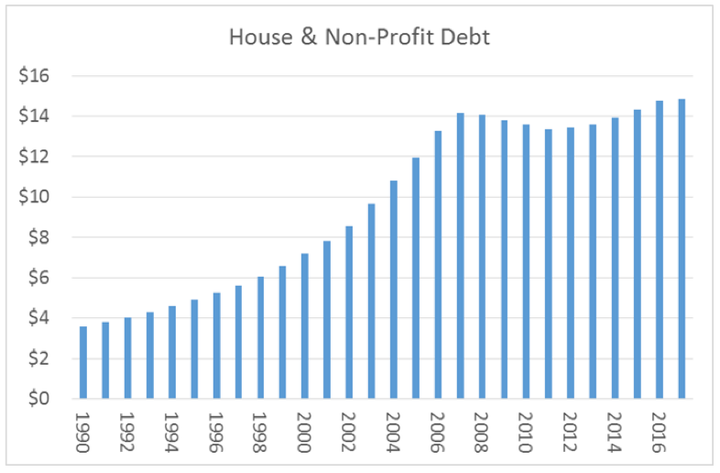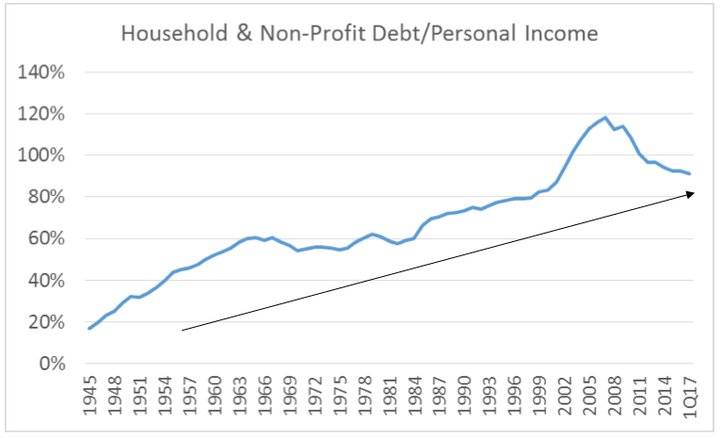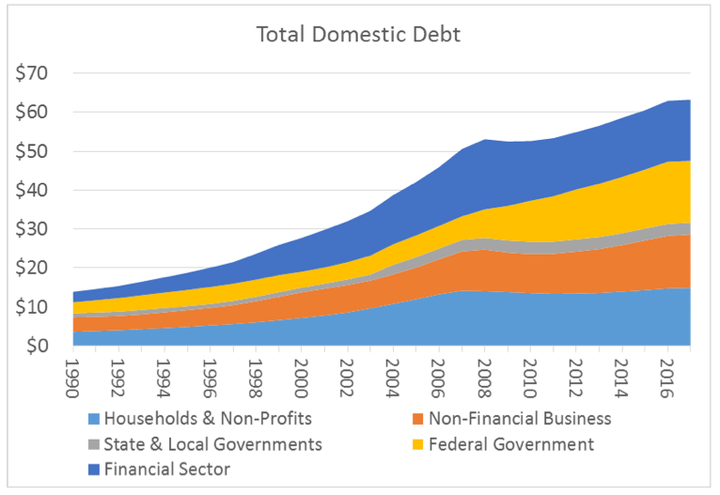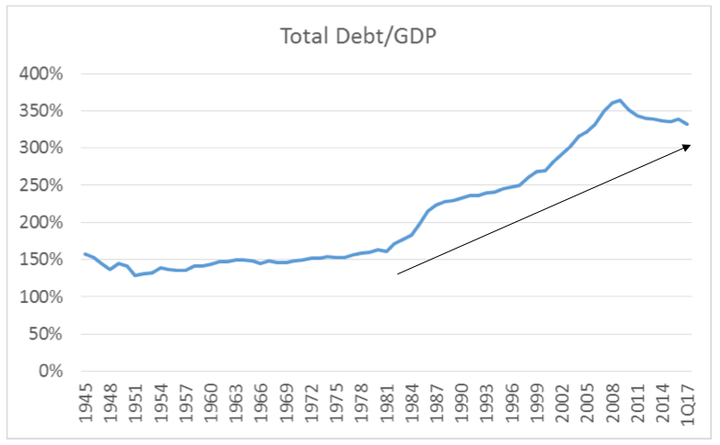Over the past few years you've probably heard an economist or two talk about "deleveraging." Deleveraging simply means debt reduction, and you've most likely heard the word used in the context of the US consumer. You may have heard something like this: "The process of deleveraging since the financial crisis has left the average consumer's balance sheet in much better shape." The health of the consumer's balance sheet is of utmost importance to the US economy as consumer spending represents over two-thirds of Gross Domestic Product (GDP). Because people must either earn more or borrow more in order to spend more, it is very important that the consumer has the capacity to borrow more. This is especially true during extended periods of subdued income growth, such as we have endured for the past many years.
The first chart below shows the trends in consumer debt since 1990. We included non-profits, which only contribute nominally, because the Federal Reserve reports the data in this format. In any case, you can see that on an absolute basis, the consumer did indeed reduce his debt loan moderately during the Great Recession. The reduction was due to both debt repayments and credit losses, which essentially means that the bank wrote off many consumer loan balances. However, sustained growth in consumer debt over the past 4-5 years has left the consumer in record territory yet again.

*Source: Federal Reserve.
The fact that consumer debt is in record territory, in itself, isn't a major issue. If incomes are rising rapidly, for instance, this would provide the consumer with more resources to service a higher debt load. Therefore, it makes sense to relate the absolute amount of consumer debt to his earning power. In the chart below, we show the trends in the ratio of consumer debt to personal income. As you can see, the ratio is still well off the highs achieved prior to the financial crisis. However, take note that if we ignore the sharp spike prior to the financial crisis, the long-term trend remains upward.

*Source: Federal Reserve.
Next, we wanted to take a step further and show the trends in economy-wide debt. In addition to consumers and non-profits, total economy-wide debt would include that incurred by non-financial businesses, the financial sector (banks and other financial businesses), state & local governments, and the federal government. As you can see in the chart below, total debt was flat for a couple of years from 2008 to 2010, but aside from that it has been heading higher in uninterrupted fashion. During the Great Recession, decreases in consumer and financial-sector debt were offset by sharp increases in government debt, mostly at the federal level. The increase in government debt was due to stimulus spending, reductions in tax revenue and dramatic increases in transfer payments (foods stamps, unemployment benefits, disability, social security, etc.). It would not be wrong to say that to a certain extent, the federal government "assumed" much of the consumer's debt through deficit spending undertaken to reduce the severity of the economic downturn. In any case, debt should be tracked in aggregate, in our view, as all government debt must eventually be repaid through higher taxes on consumers and businesses.

*Source: Federal Reserve.
Just as with consumer debt, it is helpful to relate economy-wide debt to the economy's ability to service that debt. Therefore, in the graph below we show the ratio of total debt to GDP. Although it has pulled back from the highs, the ratio remains very high on an historical basis. The high level of this ratio is especially troublesome if we consider that 1) a few trillion in debt borrowed from the Social Security trust is not included; and 2) we are very near the point where entitlement spending on baby boomers is expected to lead to dramatic increases in federal government debt (absent some resolution to the problem).

*Source: Federal Reserve.
What is our message? Essentially, we're saying that deleveraging is a myth. Although consumer and financial-sector debt came down some during and following the economic downturn, total economy-wide debt is now well above where it was prior to the recession. Is this a disaster? It doesn't have to be. If our government can somehow find a way to address the long-term problem of entitlement spending, this would free up resources to invest in the things (like education, infrastructure, renewable energy and medical research) that are needed to improve productivity and accelerate economic growth. If we are able to achieve sustainably stronger economic growth, the debt problem would diminish substantially.
